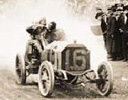Book Review
by Russell Jaslow
The Grand Prix Saboteurs
by Joe Saward
Morienval Press
ISBN: 978-0955486807. List Price: $24.99.
  Racing before World War II was incredibly dangerous, especially on European Grand Prix circuits. Safety was rudimentary at best. Cars were built to go fast with no thought towards crash worthiness. The tracks' idea of safety features were a few hay bales to "guard" the spectators from the speeding cars. Otherwise, going off course usually meant a hard encounter with a tree, ditch, or even a house. The idea of "safety teams" was decades away. A bad crash was often reported by fellow drivers as they came around to the pits. Racing before World War II was incredibly dangerous, especially on European Grand Prix circuits. Safety was rudimentary at best. Cars were built to go fast with no thought towards crash worthiness. The tracks' idea of safety features were a few hay bales to "guard" the spectators from the speeding cars. Otherwise, going off course usually meant a hard encounter with a tree, ditch, or even a house. The idea of "safety teams" was decades away. A bad crash was often reported by fellow drivers as they came around to the pits.
To be a driver during that time period took a special sort of courage and daring, knowing that every time you stepped in a car could be your last. And, to continue this career after seeing so many of your fellow drivers killed in races takes a perseverance many of us never experience. Thus, it's probably not too surprising when WWII broke out, many drivers didn't take the easy way out and use favors from their star status, and instead got heavily involved in the war effort, no matter how dangerous the work was.
Three Grand Prix drivers got involved in some of the most dangerous work -- the French Resistance. The general aspects of their story have been known for a long time. Now, the entire story and all the details are told by Joe Saward in The Grand Prix Saboteurs, a book that was the completion of 18 years of research, overcoming opposition from some who did not want the whole story to come to light. The appropriate subtitle to the book is The extraordinary untold story of the Grand Prix drivers who became British secret agents in World War II.
The story centers around two drivers, rivals on the track and friends off, who had achieved international fame before the War. The mysterious "W Williams" was the first winner of the Monaco Grand Prix in 1929 as well as the winner of the famed French Grand Prix in 1928 and 1929 and was a regular Bugatti factory driver. Being an Englishman who grew up in France, his ability to speak the language was a great asset to the British Special Operations Executive (SOE), a unit personally set up by Winston Churchill.
Robert Benoist became a French driving hero mostly as a Bugatti factory driver. He won his home Grand Prix in 1925 and 1927 (when he also won the Spanish, Italian, and British Grands Prix, the first to take those four races in the same year), as well as the 1937 24 Hours of Le Mans. He was recruited by "Williams" and eagerly joined the French Resistance.
Later, Benoist pulled in Jean-Pierre Wimille, another Bugatti driver, who co-drove with Benoist at Le Mans in 1937 and won again in 1939. He also took the French Grand Prix in 1936.
Saward tells the tale as a detailed historical piece with numerous facts and names. This means he spares no details, which shows how a lot of the work as a secret agent is mundane at times involving a lot of waiting around. However, he clearly makes sure you are aware of the constant danger these men were in. You never knew when you might be betrayed by a fellow agent, friend, family member, or even lover. You never could afford to let your guard down.
The pace and tension of the story increases the closer it gets to D-Day. The close calls and daring escapes make for fascinating reading. Everyday, these drivers and their fellow agents, many of which were women, were just one betrayal or mistake away from an arrest and interrogation by the dreaded SS. And, being secret agents, the Nazis did not consider them prisoners of war, but rather received "special consideration" which meant incarceration not in a POW camp, but in a concentration camp (though, at the time, the agents did not know these existed). Saward does not spare us any of the gory portions, reminding us once again how brutal and bloodthirsty the Germans were.
The one beef I have with the book is the same one I have with most self published works -- the lack of proper editing. There are numerous typographical mistakes that become very annoying. They are simple enough and do not appear to have any effect on the factual accuracy of the book. However, they do have me wishing Saward spent the money for a proper editor to review the manuscript. (Note -- if you do not want to find out what happens to the protagonists until you finish reading the book, then do not read the captions for the final photo section that starts on page 243.)
As I read the book, especially the harrowing parts, I couldn't help but wonder would a Schumacher, an Alonso, a Hamilton have willingly placed themselves in extreme danger to defend their countries the way "Williams", Benoist, and Wimille did? Were the early superstars braver than today's drivers? More patriotic? Or, was it the simple case of the times making the men?
Whatever the answers, after reading The Grand Prix Saboteurs, you will realize even during the dangerous era of pre-WWII racing, true heroes were not made on the track, but off the track, risking their fortunes, their lives, and even their family's lives to fight for their country.
Copyright © 2007 by . All Rights Reserved.
|



